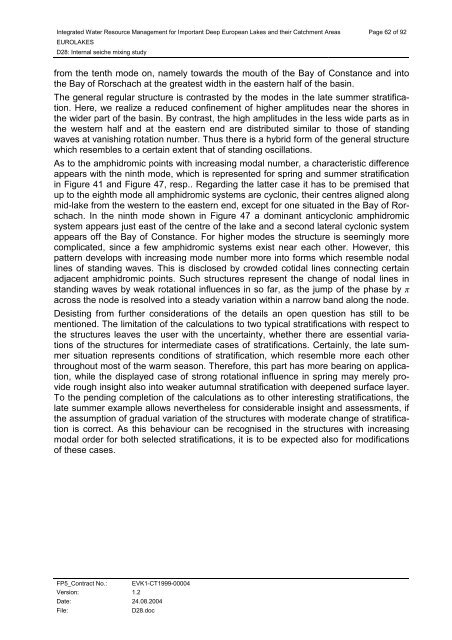D28: Internal seiche mixing study - Hydromod
D28: Internal seiche mixing study - Hydromod
D28: Internal seiche mixing study - Hydromod
You also want an ePaper? Increase the reach of your titles
YUMPU automatically turns print PDFs into web optimized ePapers that Google loves.
Integrated Water Resource Management for Important Deep European Lakes and their Catchment Areas<br />
EUROLAKES<br />
<strong>D28</strong>: <strong>Internal</strong> <strong>seiche</strong> <strong>mixing</strong> <strong>study</strong><br />
FP5_Contract No.: EVK1-CT1999-00004<br />
Version: 1.2<br />
Date: 24.08.2004<br />
File: <strong>D28</strong>.doc<br />
Page 62 of 92<br />
from the tenth mode on, namely towards the mouth of the Bay of Constance and into<br />
the Bay of Rorschach at the greatest width in the eastern half of the basin.<br />
The general regular structure is contrasted by the modes in the late summer stratification.<br />
Here, we realize a reduced confinement of higher amplitudes near the shores in<br />
the wider part of the basin. By contrast, the high amplitudes in the less wide parts as in<br />
the western half and at the eastern end are distributed similar to those of standing<br />
waves at vanishing rotation number. Thus there is a hybrid form of the general structure<br />
which resembles to a certain extent that of standing oscillations.<br />
As to the amphidromic points with increasing modal number, a characteristic difference<br />
appears with the ninth mode, which is represented for spring and summer stratification<br />
in Figure 41 and Figure 47, resp.. Regarding the latter case it has to be premised that<br />
up to the eighth mode all amphidromic systems are cyclonic, their centres aligned along<br />
mid-lake from the western to the eastern end, except for one situated in the Bay of Rorschach.<br />
In the ninth mode shown in Figure 47 a dominant anticyclonic amphidromic<br />
system appears just east of the centre of the lake and a second lateral cyclonic system<br />
appears off the Bay of Constance. For higher modes the structure is seemingly more<br />
complicated, since a few amphidromic systems exist near each other. However, this<br />
pattern develops with increasing mode number more into forms which resemble nodal<br />
lines of standing waves. This is disclosed by crowded cotidal lines connecting certain<br />
adjacent amphidromic points. Such structures represent the change of nodal lines in<br />
standing waves by weak rotational influences in so far, as the jump of the phase by π<br />
across the node is resolved into a steady variation within a narrow band along the node.<br />
Desisting from further considerations of the details an open question has still to be<br />
mentioned. The limitation of the calculations to two typical stratifications with respect to<br />
the structures leaves the user with the uncertainty, whether there are essential variations<br />
of the structures for intermediate cases of stratifications. Certainly, the late summer<br />
situation represents conditions of stratification, which resemble more each other<br />
throughout most of the warm season. Therefore, this part has more bearing on application,<br />
while the displayed case of strong rotational influence in spring may merely provide<br />
rough insight also into weaker autumnal stratification with deepened surface layer.<br />
To the pending completion of the calculations as to other interesting stratifications, the<br />
late summer example allows nevertheless for considerable insight and assessments, if<br />
the assumption of gradual variation of the structures with moderate change of stratification<br />
is correct. As this behaviour can be recognised in the structures with increasing<br />
modal order for both selected stratifications, it is to be expected also for modifications<br />
of these cases.









